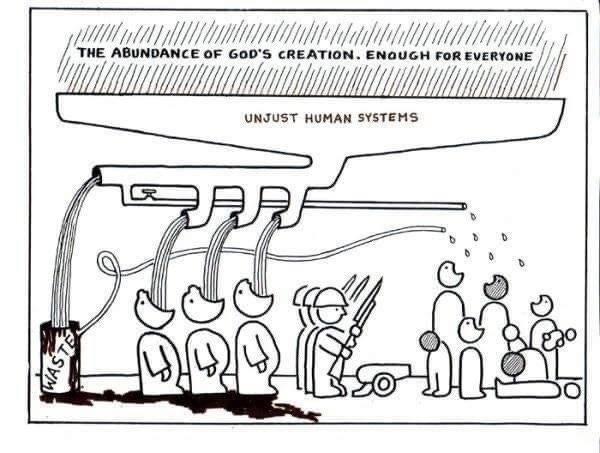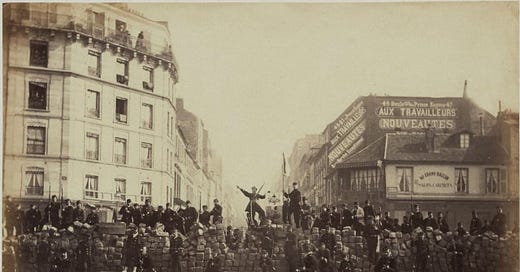In search of communal luxury
How a three-month period of French resistance in 1871 can inspire future social organization
In 1871, France found itself at the mercy of the Prussians. Despite the capture of Napoleon III by their enemy, many Parisians refused to submit. Instead, they applied tactics reminiscent of the French Revolution of nearly 100 years prior, barricading the streets and creating, for a brief 3 month period, a community led by workers and artisans.
The Paris Commune is called such due to France’s system of administration, communes being the smallest division thereof, but their ideals have certainly resonated with communists and leftists ever since. But we’re not here to rehash events that have been told and retold already many times. We’re here because a phrase coined by Eugène Pottier, Courbet and other artists who wrote the commune’s manifesto.
In the document’s last line, it says “l’inauguration du luxe communal”. The inauguration of communal luxury. You see, the Communards revolted against the system of economic and political oppression that forced them to navigate life as survival. They wanted more. They wanted art and beauty to belong to everyone, not just the elite.

This concept relates directly to topics of environmental preservation and social inclusion. After all, we are approaching tipping points across multiple planetary boundaries due to the actions of the few who have exploited natural and human resources relentlessly only to accumulate private wealth and luxuries at the expense of the rest of the living world.
The scarcity that most of the population experiences is, in fact, artificial and manufactured in order to facilitate further wealth hoarding. There is no global food shortage, only systems of distribution and profit that funnel resources like food to the countries that can pay the highest prices for them.
The Communards knew that they were getting the short end of the stick and that a different way of life was not only possible, but within reach. Unfortunately, their social experiment was terminated in the bloodiest way possible. The French government violently suppressed them, killing thousands and exiling many more to New Caledonia, their colonies off the coast of Australia.

The end of the Paris Commune was tragic, but not surprising. Those in power will always crush the visionaries that present more compelling and hopeful paths to the future— those who prove that a better way of life is possible— since they threaten the established order that sustains them. Nevertheless, the Communards’ ideas live on and inspire many today.
I came across the term communal luxury, myself, during the ChangeNOW conference this year in Paris. It has been adopted by environmentalists to illustrate a future in which the good of the people is put first instead of that of corporations and billionaires. They imagine a world where yes, wealth is capped, but no one lacks for anything. Where luxury is public, and everyone has equal access to enjoy it. Where luxury is communal.
This can look like public housing where efficiency and utilitarianism aren’t the guiding principles. Instead, the aim is to design spaces where residents can achieve the best quality of life. Public bathhouses have been written about by others as an example of communal luxury. After all, even the grandest of them were open to everyone in the community, from the poorest to the richest.

These are examples of urban architecture and planning, which are under our direct control. We can choose to design our cities to be more hospitable to their inhabitants. It’s up to our community leaders to choose to do so. Despite that, there’s still those who push for building structures that are undeniably hostile and incompatible with human flourishing. The rise of windowless student housing in the United States is a prime example.
But the concept of communal luxury extends past just our built environment. If we come to an agreement, as a society, that everyone has the right to beauty and there should be such a thing as public beauty, doesn’t the living world play a critical role in achieving this? Those who pollute our air and water are thus infringing on our right to live in pleasing circumstances. Not to mention the rights of non-human beings.
These concepts are extremely harmonious. After all, communal structures like bathhouses or public housing are often less resource intensive than the infrastructure required to serve single-family homes and especially single-person households for the same reasons that urban clusters are more resource efficient than rural sprawl.
Shifting to a mindset of communal luxury will allow those in wealthier countries to make the cuts needed to reduce their carbon footprints and resource consumption without having to sacrifice quality of life. It also blazes a path for those in lower income countries to provide better amenities and access to all their citizens without adopting a westernized, resource intensive lifestyle.
It shouldn’t be controversial for governments to implement new urban planning systems for the good of their people. In my personal opinion, that’s what we have governments for in the first place, to ensure their citizens’ quality of life. However, as with all revolutionary ideas, there will be resistance. Hopefully, by demonstrating the benefits of concepts like communal luxury to the masses, they can flex their muscle and overcome the resistance of the vocal minority that has silenced them so far.
Once the people have a taste of communal luxury, of public beauty, and understand that it is their right, I don’t think there will be any going back. Our mission now is to let them sample it.





Beautifully said! If only those in power were not more interested in protecting their privilege 😞